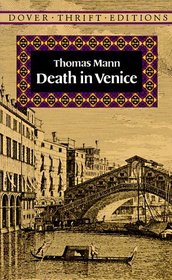"A haunting new translation"
Celebrated novella of a middle-aged German writers tormented passion for a Polish youth met on holiday in Venice, and its tragic consequences. Powerful evocation of the mysterious forces of death and disintegration in the midst of existence, and the isolation of the artist in 20th-century life. This edition provides an excellent new translation and extensive commentary on many facets of the story.
Book Description
One of the most famous literary works of the 20th century, the novella "Death in Venice" embodies themes that preoccupied Thomas Mann (18751955) in much of his work; the duality of art and life, the presence of death and disintegration in the midst of existence, the connection between love and suffering, and the conflict between the artist and his inner self. Mann's handling of these concerns in this story of a middle-aged German writer, torn by his passion for a Polish youth met on holiday in Venice, resulted in a work of great psychological intensity and tragic power. It is presented here in an excellent new translation with extensive commentary on many facets of the story.
My Review
I did not really care much for this novella by Thomas Mann which is considered a classical masterpiece. It is a very disturbing short story about Aschenbach, a famous writer, and his fascination for a beautiful 14 year-old young boy. Although he only stalks the boy, his death is a result of his obsession by not leaving Venice during an outbreak of cholera. There is lots of symbolism in the work and for being written in 1911 the subject matter of male heterosexuality was unheard of. I would like to read other books by Thomas Mann because I do believe him to be a talented writer but I think the subject matter turned me off from really liking this one. I would recommend it to those who would like to read about the destruction powers of the mind that could live within us.
One of the most famous literary works of the 20th century, the novella "Death in Venice" embodies themes that preoccupied Thomas Mann (18751955) in much of his work; the duality of art and life, the presence of death and disintegration in the midst of existence, the connection between love and suffering, and the conflict between the artist and his inner self. Mann's handling of these concerns in this story of a middle-aged German writer, torn by his passion for a Polish youth met on holiday in Venice, resulted in a work of great psychological intensity and tragic power. It is presented here in an excellent new translation with extensive commentary on many facets of the story.
My Review
I did not really care much for this novella by Thomas Mann which is considered a classical masterpiece. It is a very disturbing short story about Aschenbach, a famous writer, and his fascination for a beautiful 14 year-old young boy. Although he only stalks the boy, his death is a result of his obsession by not leaving Venice during an outbreak of cholera. There is lots of symbolism in the work and for being written in 1911 the subject matter of male heterosexuality was unheard of. I would like to read other books by Thomas Mann because I do believe him to be a talented writer but I think the subject matter turned me off from really liking this one. I would recommend it to those who would like to read about the destruction powers of the mind that could live within us.




